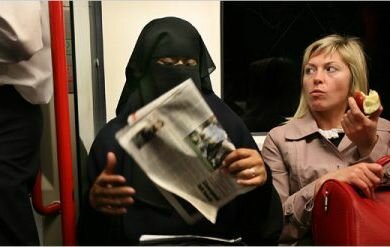The Veil: Does it protect Muslim women or subjugate them?
Middle East, Women — By Guest Author on June 8, 2010 at 06:55By Karina Tayag
The Qur’an says that the purpose of women wearing the veil was so that they may be identified and not harmed. The Muslim veil is referred to as the hijab or niqab. Wikipedia defines hijab as “both the head covering traditionally worn by Muslim women and modest Muslim styles of dress in general.” Hijab is an Arabic word that means curtain or cover.
According to the “Encyclopedia of Islam and the Muslim World”:
The term hijab or veil is not used in the Qur’an to refer to an article of clothing for women or men, rather it refers to a spatial curtain that divides or provides privacy. The Qur’an instructs the male believers (Muslims) to talk to wives of Prophet Muhammad behind a hijab. This hijab was the responsibility of the men and not the wives of Prophet Muhammad. However, in later Muslim societies this instruction, specific to the wives of Prophet Muhammad, was generalized, leading to the segregation of the Muslim men and women.
Throughout the Islamic world, the practice of wearing veils varies. In Turkey—a secular but predominantly Muslim country—some women wear Western clothes as any European woman would and other women dress very conservatively with a colorful headscarf. But in Saudi Arabia—an oil-rich country—women are not allowed to go out in public without wearing an abaya (Arabic word for cloak) that even foreign women are subject to it. The abaya is a long over-garment essentially a robe-like dress with black as the most predominant color among Muslim women.
The practice of hijab, as in modest Muslim dress, is used to protect men and women from sexual immorality. But the segregation of men and women in the Islamic world has skewed the understanding of the opposite sex, which has led to the undermining and abuse of Muslim women. The mosque is where the segregation is most obvious. Men would worship in one room and women in another.
In some Muslim (especially in the Middle East) countries, women have little to no legal rights and are treated as second-class citizens. When I was in college more than ten years ago, I was shocked to learned from a female friend who is Saudi Arabian that she, as a woman, could not drive there. And recently through an online article about a young girl who arrived in Saudi Arabia early this year to visit her father, women need permission of their husbands or a male relative to travel. For some unknown reason, the father has taken her passport and all other identity documents. Up to this day, she is still in Saudi Arabia even with all the legal assistance she has been receiving from outside.
In France, the veil is being attacked. First, the French parliament tried to ban the veil in schools in fear of more segregation a couple of years ago. In all its history, France has been opened to migrants from other cultures and other continents. In my own experience, I have friends and acquaintances that are not your typical Caucasian French. A lot of them have roots that go back to Africa. It is because the veil makes the Muslim female stand out is the reasoning behind the ban. Though they did not succeed in that, the French parliament has proposed a full ban of face-covering veils in most public places in January.
“This divisive approach is a denial of the equality between men and women and a rejection of co-existence side-by-side, without which our republic is nothing,” says Bernard Accoyer, the French National Assembly speaker. “It is the symbol of the repression of women, and… of extremist fundamentalism,” he explained.
###
 Karina Tayag is a human rights activist and writer. She earned a Bachelor of Fine Arts in Public Relations from Long Island University, C.W. Post Campus in Brookville, NY.
Karina Tayag is a human rights activist and writer. She earned a Bachelor of Fine Arts in Public Relations from Long Island University, C.W. Post Campus in Brookville, NY.
Author: Guest Author (94 Articles)



 Share This
Share This Tweet This
Tweet This Digg This
Digg This Save to delicious
Save to delicious Stumble it
Stumble it





 Organizing Latino Immigrants for Social Justice
Organizing Latino Immigrants for Social Justice De-biasing implicit bias: Start with our schools
De-biasing implicit bias: Start with our schools







